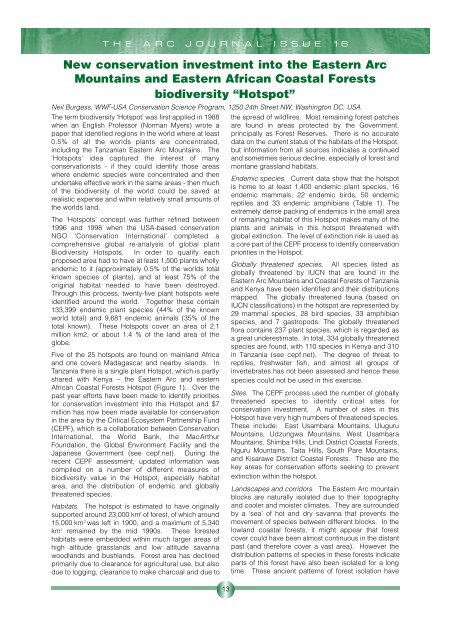Eastern Arc Mountains and Coastal Forests of Tanzania and Kenya ...
Eastern Arc Mountains and Coastal Forests of Tanzania and Kenya ...
Eastern Arc Mountains and Coastal Forests of Tanzania and Kenya ...
Create successful ePaper yourself
Turn your PDF publications into a flip-book with our unique Google optimized e-Paper software.
T H E A R C J O U R N A L I S S U E 1 6New conservation investment into the <strong>Eastern</strong> <strong>Arc</strong><strong>Mountains</strong> <strong>and</strong> <strong>Eastern</strong> African <strong>Coastal</strong> <strong>Forests</strong>biodiversity “Hotspot”Neil Burgess, WWF-USA Conservation Science Program, 1250 24th Street NW, Washington DC, USAThe term biodiversity ‘Hotspot’ was first applied in 1988when an English Pr<strong>of</strong>essor (Norman Myers) wrote apaper that identified regions in the world where at least0.5% <strong>of</strong> all the worlds plants are concentrated,including the <strong>Tanzania</strong>n <strong>Eastern</strong> <strong>Arc</strong> <strong>Mountains</strong>. The‘Hotspots’ idea captured the interest <strong>of</strong> manyconservationists - if they could identify those areaswhere endemic species were concentrated <strong>and</strong> thenundertake effective work in the same areas - then much<strong>of</strong> the biodiversity <strong>of</strong> the world could be saved atrealistic expense <strong>and</strong> within relatively small amounts <strong>of</strong>the worlds l<strong>and</strong>.The ‘Hotspots’ concept was further refined between1996 <strong>and</strong> 1998 when the USA-based conservationNGO ‘Conservation International’ completed ac o m p rehensive global re-analysis <strong>of</strong> global plantBiodiversity Hotspots. In order to qualify eachproposed area had to have at least 1,500 plants whollyendemic to it (approximately 0.5% <strong>of</strong> the worlds totalknown species <strong>of</strong> plants), <strong>and</strong> at least 75% <strong>of</strong> theoriginal habitat needed to have been destro y e d .Through this process, twenty-five plant hotspots wereidentified around the world. Together these contain133,399 endemic plant species (44% <strong>of</strong> the knownworld total) <strong>and</strong> 9,681 endemic animals (35% <strong>of</strong> thetotal known). These Hotspots cover an area <strong>of</strong> 2.1million km2, or about 1.4 % <strong>of</strong> the l<strong>and</strong> area <strong>of</strong> theglobe.Five <strong>of</strong> the 25 hotspots are found on mainl<strong>and</strong> Africa<strong>and</strong> one covers Madagascar <strong>and</strong> nearby isl<strong>and</strong>s. In<strong>Tanzania</strong> there is a single plant Hotspot, which is partlyshared with <strong>Kenya</strong> – the <strong>Eastern</strong> <strong>Arc</strong> <strong>and</strong> easternAfrican <strong>Coastal</strong> <strong>Forests</strong> Hotspot (Figure 1). Over thepast year efforts have been made to identify prioritiesfor conservation investment into this Hotspot <strong>and</strong> $7million has now been made available for conservationin the area by the Critical Ecosystem Partnership Fund(CEPF), which is a collaboration between ConservationI n t e rnational, the World Bank, the MacArt h u rFoundation, the Global Environment Facility <strong>and</strong> theJapanese Government (see cepf.net). During therecent CEPF assessment, updated information wascompiled on a number <strong>of</strong> diff e rent measures <strong>of</strong>biodiversity value in the Hotspot, especially habitatarea, <strong>and</strong> the distribution <strong>of</strong> endemic <strong>and</strong> globallythreatened species.Habitats. The hotspot is estimated to have originallysupported around 23,000 km 2 <strong>of</strong> forest, <strong>of</strong> which around15,000 km 2 was left in 1900, <strong>and</strong> a maximum <strong>of</strong> 5,340km 2 remained by the mid 1990s. These forestedhabitats were embedded within much larger areas <strong>of</strong>high altitude grassl<strong>and</strong>s <strong>and</strong> low altitude savannawoodl<strong>and</strong>s <strong>and</strong> bushl<strong>and</strong>s. Forest area has declinedprimarily due to clearance for agricultural use, but alsodue to logging, clearance to make charcoal <strong>and</strong> due to13the spread <strong>of</strong> wildfires. Most remaining forest patchesare found in areas protected by the Government,principally as Forest Reserves. There is no accuratedata on the current status <strong>of</strong> the habitats <strong>of</strong> the Hotspot,but information from all sources indicates a continued<strong>and</strong> sometimes serious decline, especially <strong>of</strong> forest <strong>and</strong>montane grassl<strong>and</strong> habitats.Endemic species. Current data show that the hotspotis home to at least 1,400 endemic plant species, 16endemic mammals, 22 endemic birds, 50 endemicreptiles <strong>and</strong> 33 endemic amphibians (Table 1). Theextremely dense packing <strong>of</strong> endemics in the small area<strong>of</strong> remaining habitat <strong>of</strong> this Hotspot makes many <strong>of</strong> theplants <strong>and</strong> animals in this hotspot threatened withglobal extinction. The level <strong>of</strong> extinction risk is used asa core part <strong>of</strong> the CEPF process to identify conservationpriorities in the Hotspot.Globally threatened species. All species listed asglobally threatened by IUCN that are found in the<strong>Eastern</strong> <strong>Arc</strong> <strong>Mountains</strong> <strong>and</strong> <strong>Coastal</strong> <strong>Forests</strong> <strong>of</strong> <strong>Tanzania</strong><strong>and</strong> <strong>Kenya</strong> have been identified <strong>and</strong> their distributionsmapped. The globally threatened fauna (based onIUCN classifications) in the hotspot are represented by29 mammal species, 28 bird species, 33 amphibianspecies, <strong>and</strong> 7 gastropods. The globally threatenedflora contains 237 plant species, which is regarded asa great underestimate. In total, 334 globally threatenedspecies are found, with 110 species in <strong>Kenya</strong> <strong>and</strong> 310in <strong>Tanzania</strong> (see cepf.net). The degree <strong>of</strong> threat toreptiles, freshwater fish, <strong>and</strong> almost all groups <strong>of</strong>invertebrates has not been assessed <strong>and</strong> hence thesespecies could not be used in this exercise.Sites. The CEPF process used the number <strong>of</strong> globallyt h reatened species to identify critical sites forconservation investment. A number <strong>of</strong> sites in thisHotspot have very high numbers <strong>of</strong> threatened species.These include: East Usambara <strong>Mountains</strong>, Uluguru<strong>Mountains</strong>, Udzungwa <strong>Mountains</strong>, West Usambara<strong>Mountains</strong>, Shimba Hills, Lindi District <strong>Coastal</strong> <strong>Forests</strong>,Nguru <strong>Mountains</strong>, Taita Hills, South Pare <strong>Mountains</strong>,<strong>and</strong> Kisarawe District <strong>Coastal</strong> <strong>Forests</strong>. These are thekey areas for conservation efforts seeking to preventextinction within the hotspot.L<strong>and</strong>scapes <strong>and</strong> corridors. The <strong>Eastern</strong> <strong>Arc</strong> mountainblocks are naturally isolated due to their topography<strong>and</strong> cooler <strong>and</strong> moister climates. They are surroundedby a ‘sea’ <strong>of</strong> hot <strong>and</strong> dry savanna that prevents themovement <strong>of</strong> species between different blocks. In thelowl<strong>and</strong> coastal forests, it might appear that forestcover could have been almost continuous in the distantpast (<strong>and</strong> therefore cover a vast area). However thedistribution patterns <strong>of</strong> species in these forests indicateparts <strong>of</strong> this forest have also been isolated for a longtime. These ancient patterns <strong>of</strong> forest isolation have
















